Abstract
The mechanism of the onset of labor is unknown in humans and guinea pigs. Contrary to most other species, progesterone withdrawal appears not to precede the onset of labor. To elucidate the role of oxytocin in the onset and maintenance of labor, guinea pigs were fitted with vascular catheters, an intraabdominal pressure catheter and an array of uterine electromyogram electrodes. An oxytocin antagonist (des-Gly9-[D-Trp2,Thr4,Orn8]dC6-oxytocin, 20 micrograms/kg per h, n = 11) or saline solution (n = 12) was infused starting on day 66 of gestation (term is 69 d). Oxytocin receptor blockade resulted in decreased uterine activity and a prolonged expulsive phase (second stage) of labor. Fetal delivery was delayed and fetal mortality was increased. The onset of the expulsive phase of labor was delayed but maximum uterine activity occurred in time together with a timely change in uterine electromyogram activity from a prepartum to a postpartum pattern following an unaltered progressive increase in baseline uterine activity. This indicates that oxytocin is requisite for the normal progress of the first and second stage of labor, but has no involvement in the mechanism of the onset and the timing of labor.
Full text
PDF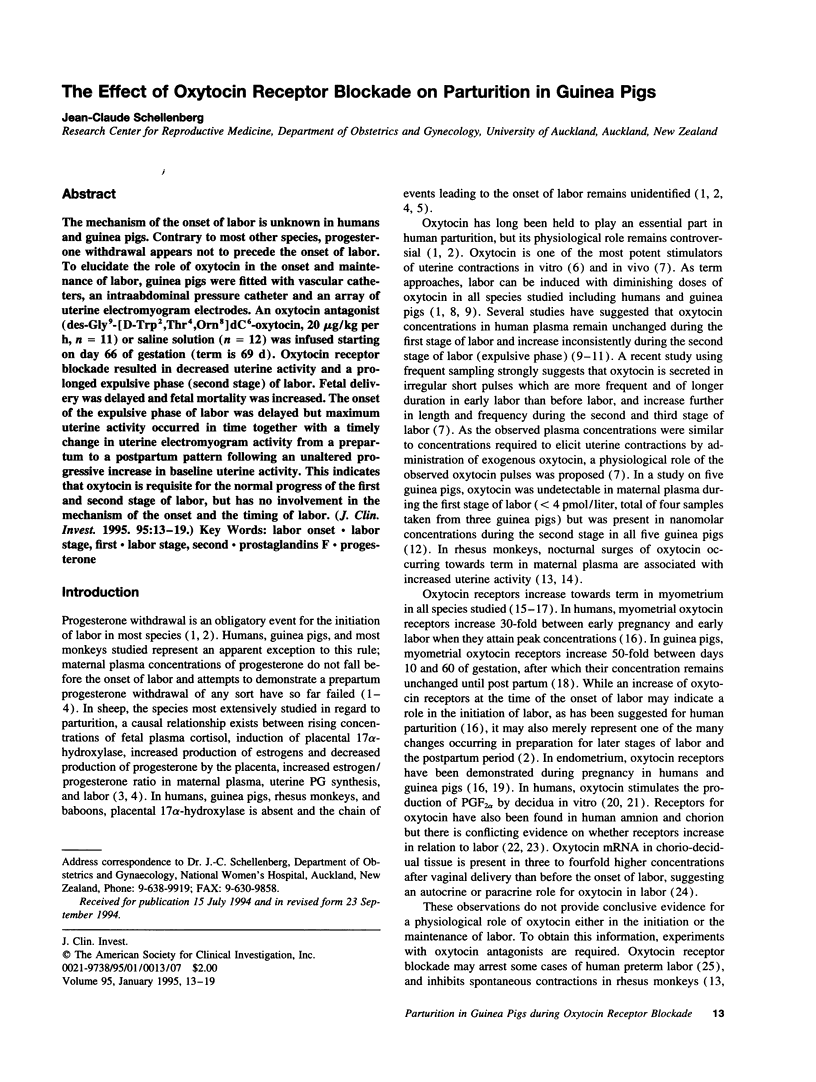
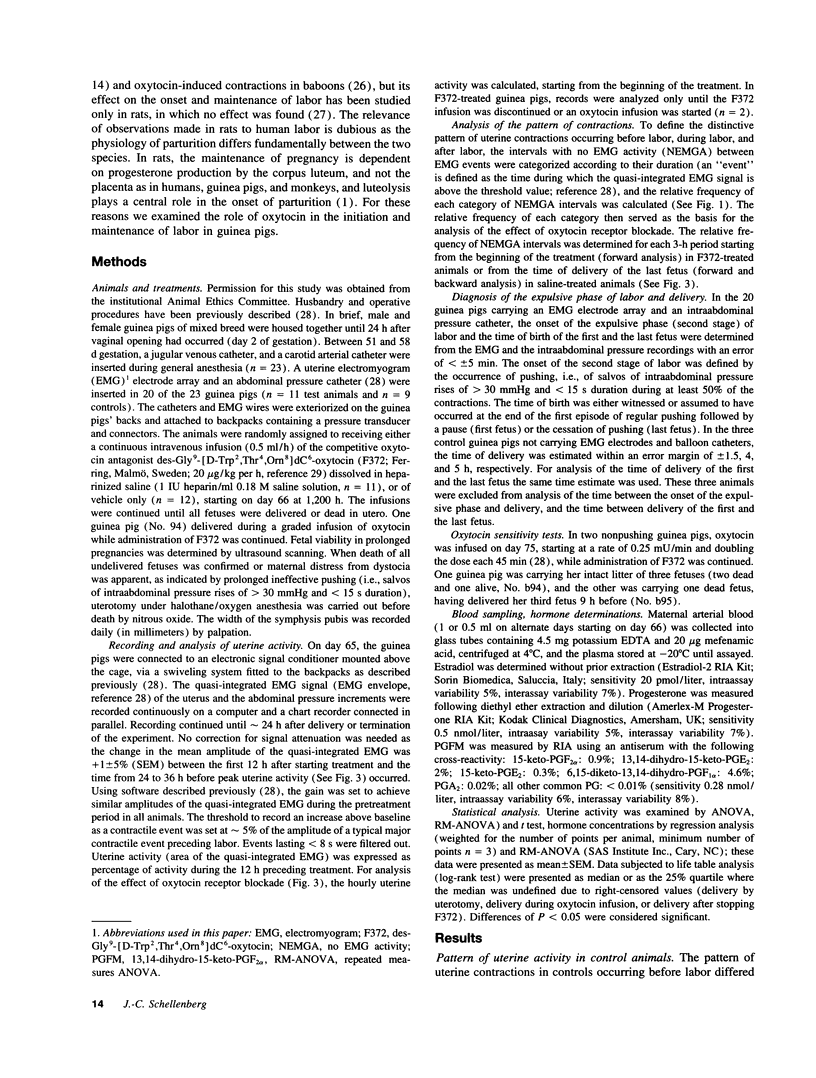
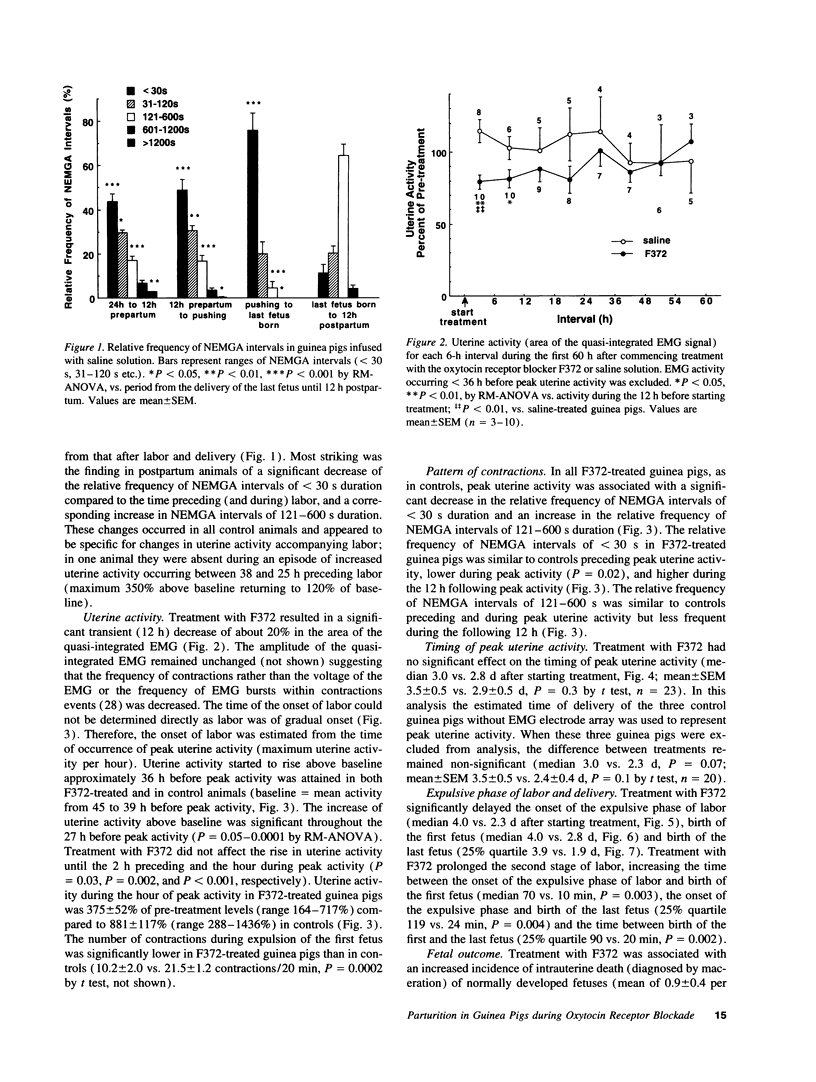
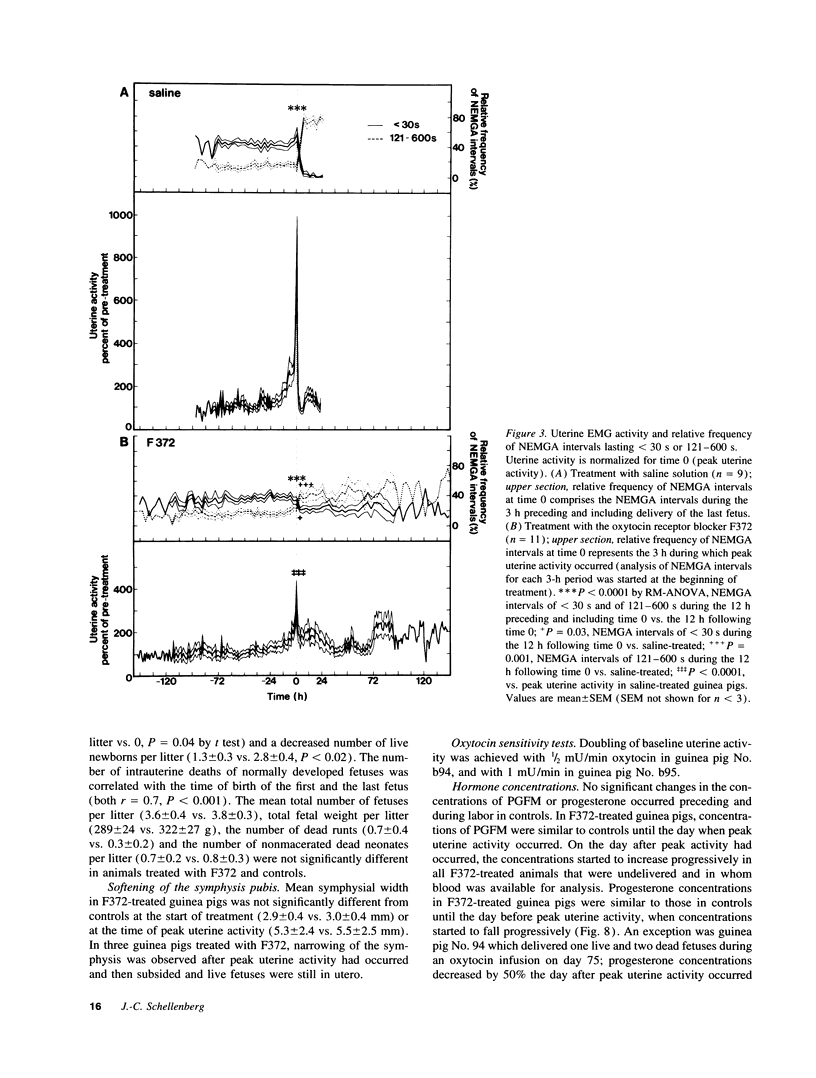
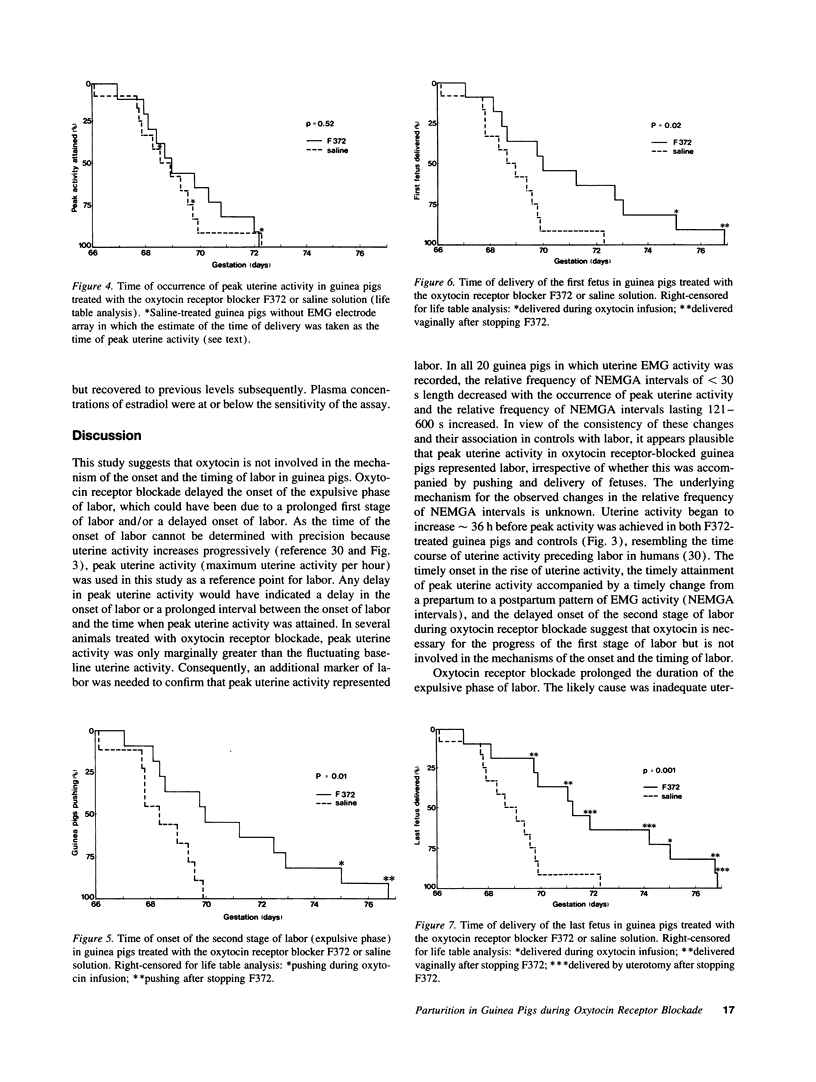
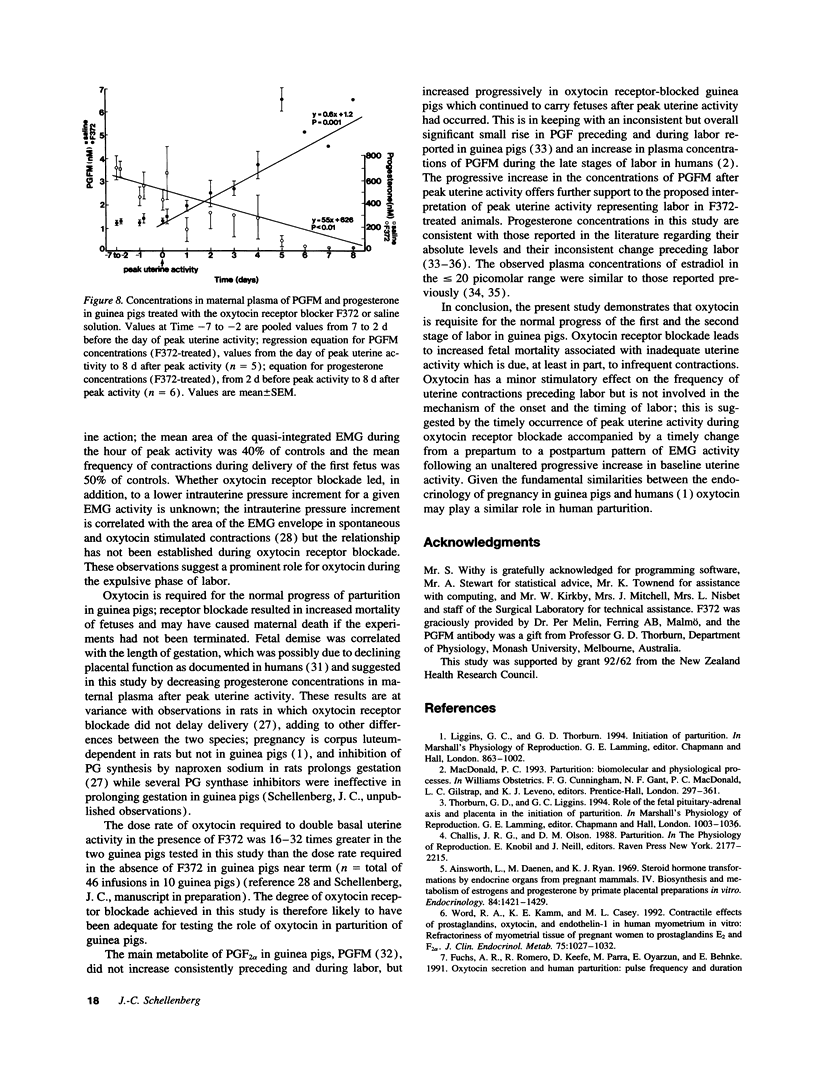
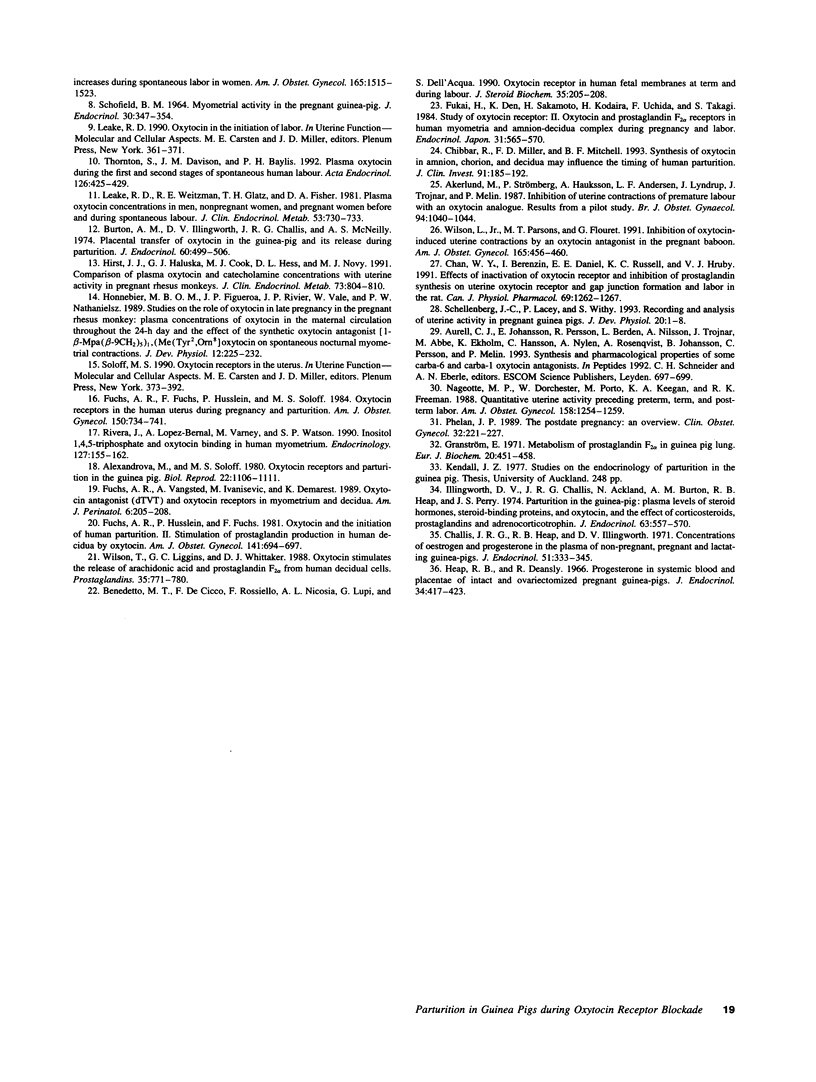
Selected References
These references are in PubMed. This may not be the complete list of references from this article.
- Ainsworth L., Daenen M., Ryan K. J. Steroid hormone transformations by endocrine organs from pregnant mammals. IV. Biosynthesis and metabolism of estrogens and progesterone by primate placental preparations in vitro. Endocrinology. 1969 Jun;84(6):1421–1429. doi: 10.1210/endo-84-6-1421. [DOI] [PubMed] [Google Scholar]
- Akerlund M., Strömberg P., Hauksson A., Andersen L. F., Lyndrup J., Trojnar J., Melin P. Inhibition of uterine contractions of premature labour with an oxytocin analogue. Results from a pilot study. Br J Obstet Gynaecol. 1987 Nov;94(11):1040–1044. doi: 10.1111/j.1471-0528.1987.tb02287.x. [DOI] [PubMed] [Google Scholar]
- Alexandrova M., Soloff M. S. Oxytocin receptors and parturition in the guinea pig. Biol Reprod. 1980 Jun;22(5):1106–1111. doi: 10.1093/biolreprod/22.5.1106. [DOI] [PubMed] [Google Scholar]
- Benedetto M. T., De Cicco F., Rossiello F., Nicosia A. L., Lupi G., Dell'Acqua S. Oxytocin receptor in human fetal membranes at term and during labor. J Steroid Biochem. 1990 Feb;35(2):205–208. doi: 10.1016/0022-4731(90)90276-x. [DOI] [PubMed] [Google Scholar]
- Butron A. M., Illingworth D. V., Challis J. R., McNeilly A. S. Placental transfer of oxytocin in the guinea-pig and its release during parturition. J Endocrinol. 1974 Mar;60(3):499–506. doi: 10.1677/joe.0.0600499. [DOI] [PubMed] [Google Scholar]
- Challis J. R., Heap R. B., Illingworth D. V. Concentrations of oestrogen and progesterone in the plasma of non-pregnant, pregnant and lactating guinea-pigs. J Endocrinol. 1971 Oct;51(2):333–345. doi: 10.1677/joe.0.0510333. [DOI] [PubMed] [Google Scholar]
- Chan W. Y., Berezin I., Daniel E. E., Russell K. C., Hruby V. J. Effects of inactivation of oxytocin receptor and inhibition of prostaglandin synthesis on uterine oxytocin receptor and gap junction formation and labor in the rat. Can J Physiol Pharmacol. 1991 Sep;69(9):1262–1267. doi: 10.1139/y91-185. [DOI] [PubMed] [Google Scholar]
- Chibbar R., Miller F. D., Mitchell B. F. Synthesis of oxytocin in amnion, chorion, and decidua may influence the timing of human parturition. J Clin Invest. 1993 Jan;91(1):185–192. doi: 10.1172/JCI116169. [DOI] [PMC free article] [PubMed] [Google Scholar]
- Fuchs A. R., Fuchs F., Husslein P., Soloff M. S. Oxytocin receptors in the human uterus during pregnancy and parturition. Am J Obstet Gynecol. 1984 Nov 15;150(6):734–741. doi: 10.1016/0002-9378(84)90677-x. [DOI] [PubMed] [Google Scholar]
- Fuchs A. R., Husslein P., Fuchs F. Oxytocin and the initiation of human parturition. II. Stimulation of prostaglandin production in human decidua by oxytocin. Am J Obstet Gynecol. 1981 Nov 15;141(6):694–697. doi: 10.1016/s0002-9378(15)33313-5. [DOI] [PubMed] [Google Scholar]
- Fuchs A. R., Romero R., Keefe D., Parra M., Oyarzun E., Behnke E. Oxytocin secretion and human parturition: pulse frequency and duration increase during spontaneous labor in women. Am J Obstet Gynecol. 1991 Nov;165(5 Pt 1):1515–1523. doi: 10.1016/0002-9378(91)90399-c. [DOI] [PubMed] [Google Scholar]
- Fuchs A. R., Vangsted A., Ivanisevic M., Demarest K. Oxytocin antagonist (dTVT) and oxytocin receptors in myometrium and decidua. Am J Perinatol. 1989 Apr;6(2):205–208. doi: 10.1055/s-2007-999577. [DOI] [PubMed] [Google Scholar]
- Fukai H., Den K., Sakamoto H., Kodaira H., Uchida F., Takagi S. Study of oxytocin receptor: II. oxytocin and prostaglandin F2 alpha receptors in human myometria and amnion-decidua complex during pregnancy and labor. Endocrinol Jpn. 1984 Oct;31(5):565–570. doi: 10.1507/endocrj1954.31.565. [DOI] [PubMed] [Google Scholar]
- Granström E. Metabolism of prostaglandin F2-alpha in guinea pig lung. Eur J Biochem. 1971 Jun 29;20(4):451–458. doi: 10.1111/j.1432-1033.1971.tb01413.x. [DOI] [PubMed] [Google Scholar]
- Heap R. B., Deanesly R. Progesterone in systemic blood and placentae of intact and ovariectomized pregnant guinea-pigs. J Endocrinol. 1966 Apr;34(4):417–423. doi: 10.1677/joe.0.0340417. [DOI] [PubMed] [Google Scholar]
- Hirst J. J., Haluska G. J., Cook M. J., Hess D. L., Novy M. J. Comparison of plasma oxytocin and catecholamine concentrations with uterine activity in pregnant rhesus monkeys. J Clin Endocrinol Metab. 1991 Oct;73(4):804–810. doi: 10.1210/jcem-73-4-804. [DOI] [PubMed] [Google Scholar]
- Honnebier M. B., Figueroa J. P., Rivier J., Vale W., Nathanielsz P. W. Studies on the role of oxytocin in late pregnancy in the pregnant rhesus monkey: plasma concentrations of oxytocin in the maternal circulation throughout the 24-h day and the effect of the synthetic oxytocin antagonist [1-beta-Mpa(beta-(CH2)5)1,(Me(Tyr2, Orn8] oxytocin on spontaneous nocturnal myometrial contractions. J Dev Physiol. 1989 Oct;12(4):225–232. [PubMed] [Google Scholar]
- Illingworth D. V., Challis J. R., Ackland N., Burton A. M., Heap R. B., Perry J. S. Parturition in the guinea-pig; plasma levels of steroid hormones, steroid-binding proteins, and oxytocin, and the effect of corticosteroids, prostaglandins and adrenocorticotrophin. J Endocrinol. 1974 Dec;63(3):557–570. doi: 10.1677/joe.0.0630557. [DOI] [PubMed] [Google Scholar]
- Leake R. D., Weitzman R. E., Glatz T. H., Fisher D. A. Plasma oxytocin concentrations in men, nonpregnant women, and pregnant women before and during spontaneous labor. J Clin Endocrinol Metab. 1981 Oct;53(4):730–733. doi: 10.1210/jcem-53-4-730. [DOI] [PubMed] [Google Scholar]
- Nageotte M. P., Dorchester W., Porto M., Keegan K. A., Jr, Freeman R. K. Quantitation of uterine activity preceding preterm, term, and postterm labor. Am J Obstet Gynecol. 1988 Jun;158(6 Pt 1):1254–1259. doi: 10.1016/0002-9378(88)90353-5. [DOI] [PubMed] [Google Scholar]
- Phelan J. P. The postdate pregnancy: an overview. Clin Obstet Gynecol. 1989 Jun;32(2):221–227. doi: 10.1097/00003081-198906000-00004. [DOI] [PubMed] [Google Scholar]
- Rivera J., López Bernal A., Varney M., Watson S. P. Inositol 1,4,5-trisphosphate and oxytocin binding in human myometrium. Endocrinology. 1990 Jul;127(1):155–162. doi: 10.1210/endo-127-1-155. [DOI] [PubMed] [Google Scholar]
- SCHOFIELD B. M. MYOMETRIAL ACTIVITY IN THE PREGNANT GUINEA-PIG. J Endocrinol. 1964 Oct;30:347–354. doi: 10.1677/joe.0.0300347. [DOI] [PubMed] [Google Scholar]
- Thornton S., Davison J. M., Baylis P. H. Plasma oxytocin during the first and second stages of spontaneous human labour. Acta Endocrinol (Copenh) 1992 May;126(5):425–429. doi: 10.1530/acta.0.1260425. [DOI] [PubMed] [Google Scholar]
- Wilson L., Jr, Parsons M. T., Flouret G. Inhibition of oxytocin-induced uterine contractions by an oxytocin antagonist in the pregnant baboon. Am J Obstet Gynecol. 1991 Aug;165(2):456–460. doi: 10.1016/0002-9378(91)90116-9. [DOI] [PubMed] [Google Scholar]
- Wilson T., Liggins G. C., Whittaker D. J. Oxytocin stimulates the release of arachidonic acid and prostaglandin F2 alpha from human decidual cells. Prostaglandins. 1988 May;35(5):771–780. doi: 10.1016/0090-6980(88)90149-9. [DOI] [PubMed] [Google Scholar]
- Word R. A., Kamm K. E., Casey M. L. Contractile effects of prostaglandins, oxytocin, and endothelin-1 in human myometrium in vitro: refractoriness of myometrial tissue of pregnant women to prostaglandins E2 and F2 alpha. J Clin Endocrinol Metab. 1992 Oct;75(4):1027–1032. doi: 10.1210/jcem.75.4.1400867. [DOI] [PubMed] [Google Scholar]


